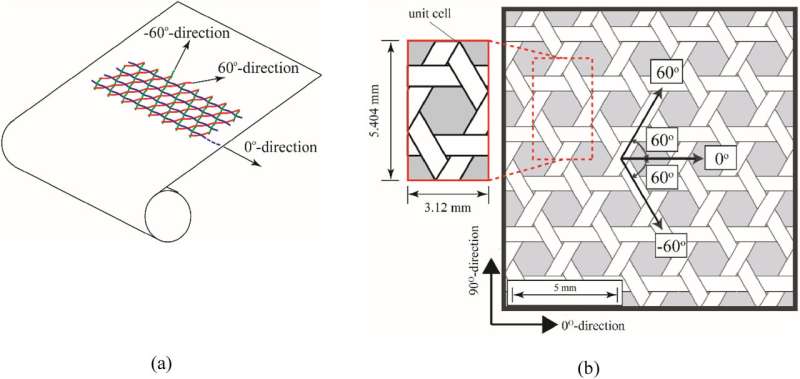This article has been reviewed according to Science X's editorial process and policies. Editors have highlighted the following attributes while ensuring the content's credibility:
fact-checked
peer-reviewed publication
proofread
Experimental analysis, computer simulations reveal how woven fabric composites are deformed by heat

Materials called triaxially woven fabric composites (TWFCs) have fibers woven together in three directions, commonly at a 60-degree angle to each other. They are increasingly used in many applications but their response to heating and cooling has not been well-studied.
Materials scientist Ahmad Kueh at the Universiti Malaysia Sarawak (UNIMAS) has now conducted a detailed examination of this significant knowledge gap. His results are published open access in the journal Heliyon.
The new experimental and theoretical understanding of a twisting motion on heating will help predict the material's structural integrity and performance in different and changeable conditions. "These innovative findings hold significant implications for a wide range of applications, especially in the design of heat-resistant materials essential for the aerospace sector," says Kueh.
When weaved using carbon fibers, then integrated with resins, TWFCs can combine the advantages of low weight, workability, strength, and resistance to corrosion. Some TWFCs are already used in applications ranging from aircraft fuselage and wing and engine components to sports equipment, including tennis rackets, golf club shafts, and bicycle frames.
Building on earlier work already published with collaborators, Kueh conducted a detailed examination, combined with computer simulations, of single sheets of a commercially available material supplied by the Sakase Adtech company. This incorporates carbon fibers manufactured by Toray Industries, Inc. in Japan.
The sheets are open-weaved, meaning the interweaved fibers are separated by regularly spaced and stable hexagonal gaps. To make a single-ply composite structure, they were combined and cured with a hot liquified polymer resin that soaked through the fibers and then solidified on cooling.
When subjected to repeated heating cycles in the range from 20°C to 100°C, the research was able to analyze a twisting motion brought about by temperature changes. Detailed quantification of the experimentally observed deformations were in good agreement with those predicted by computer simulation.
"The new understanding will unlock the potential to improve the effectiveness of TWFCs across a wide range of industries," says Kueh.
Together with colleagues, he now plans to investigate the thermal dynamics of many other TWFCs, including different weave patterns, multiple-ply structures, and hybrid materials incorporating other types of composites. This future exploration will include collaboration with industry partners to undertake the practical tests needed to gain insights relevant to real-world uses.
In addition to aerospace applications, Kueh cites many possibilities, including reinforced concrete, sports equipment, body armor, and strong heat-resistant textiles for use by firefighters.
"Our discoveries pave the way for a future in which the combination of low weight and strength transforms numerous everyday products, making them more efficient, cost-effective, and resilient," he concludes.
More information: A.B.H. Kueh, Thermally-induced responses of triaxially woven fabric composites, Heliyon (2023). DOI: 10.1016/j.heliyon.2023.e17631
Journal information: Heliyon
Provided by Universiti Malaysia Sarawak




















